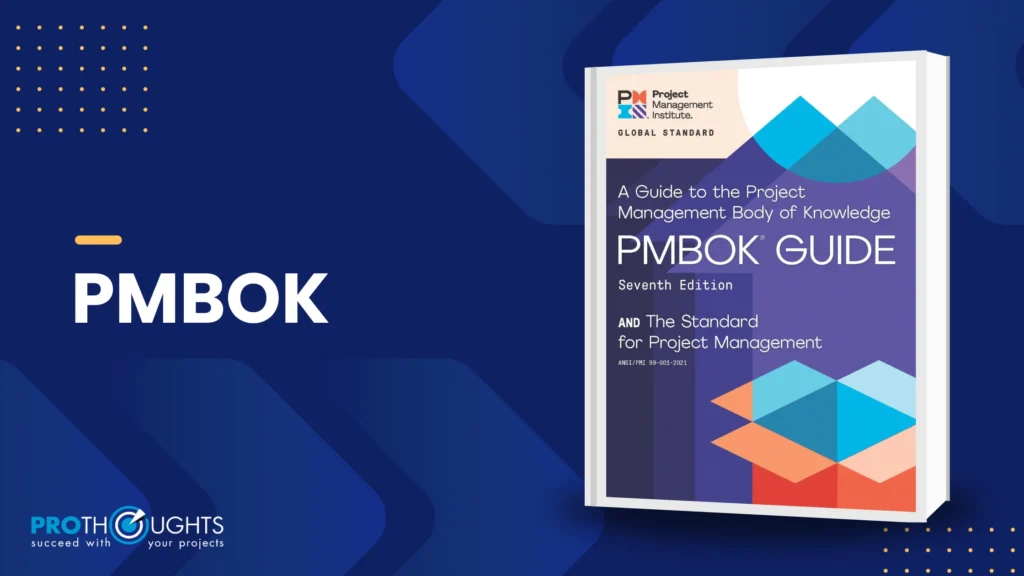The Project Management Body of Knowledge (PMBOK) is a book compiling the rules, regulations, and project management guidelines. It is a guide that lists the project management best practices and standards. The Body of Knowledge improves and evolves with time to reflect the current state of project management. The guide compiles these updates to give you new, ideal, and useful knowledge. Let’s dig into the details of PMBOK in this article!
What Is PMBOK?
PMBOK outlines the fundamental principles, regulations, and standards that guide you to achieve project perfection from start to end. It allows you to plan, execute, and manage projects effectively. The guide highlights the right project management approach and helps you enhance your skills. Moreover, by applying PMBOK standards, you can reach successful project outcomes.
The Project Management Body of Knowledge (PMBOK) Guide is recognized internationally (IEEE, ANSI) and is referred to by most institutions and project management programs. It is also a Bible for professionals pursuing project management certifications. Most project management courses incorporate the concepts of PMBOK and the standards of project management it – especially PMI certification courses. It is a fundamental guide produced by the Project Management Institute and is crucial for all its project management certifications.
There are 11 language translations of the Project Management Body of Knowledge. This has helped it become one of the most well-known resources for project managers worldwide. However, there are constant changes and advances in the profession of project, program, and portfolio management. Therefore, PMI ensures that everyone is kept updated on these new advances and standards through the PMBOK Guide.
About The Latest Version: PMBOK 7th Edition
The PMI updated the PMBOK 7th Edition to tackle the current situations and challenges in project environments. Due to PMI’s shift from prescriptive project management to principle-based one, there has been a change in the PMBOK Guide as well. After its last update in 2021, this marks the most important structural change in its revision history due to the shift from process-based to principle-based project management.
This new edition is formed to empower you with the skills and knowledge, to better deal with and manage project risks, have a problem-solving approach, and provide agility in adapting to changes. Moreover, the 7th edition does not explain the step-by-step processes or tools that must be utilized in a precise order.
The goal of the PMBOK Guide 7th Edition is to make the content more user-friendly, simpler to understand, and relevant to project managers using predictive, hybrid and adaptive, or agile, approaches.
The new edition has replaced the popular PMBOK knowledge areas with Project performance domains, tailoring, and Model, Methods, and Artifacts. Let’s look at this new outline in the next section!
Ref Source: Pmbok 6 vs Pmbok 7
What’s New In The PMBOK Latest Edition?
1. Performance Domains
In the PMBOK Guide 6th Edition, the framework involved the roles of project managers and various knowledge areas that are essential for successful project management. However, the recent edition has replaced the old edition with the 8 performance domains. It covers the important areas of project management for achieving the project goals. Here’s a simpler explanation of each domain:
-
Stakeholders
This domain focuses on engaging stakeholders throughout the project to identify and understand their needs and expectations. Through clear and effective communication it becomes easy to understand what stakeholders require which makes achieving the project objectives easy.
-
Team
The team performance domain focuses on guiding and motivating the team members to achieve the project goals through effective leadership skills. It emphasizes more on continuous learning, enhancing the skills of the team members and empowering them to make decisions, therefore, increasing the harmony and productivity of the team.
-
Development Approach and Life Cycle
Choosing the appropriate project management techniques, tailoring them to the project’s requirements, efficiently managing project stages, and maintaining consistency across the project life cycle are all part of the Development Approach and Life Cycle.
-
Planning
This domain focuses on setting a clear direction for the project. Specifically, it involves the project scope, requirements, schedule, and budget planning. Furthermore, planning helps in finding out the possible risks that can occur and preparing the solutions. Therefore, ensuring everyone is on the same page about the project goals and is clear on how to work towards them.
-
Project Work
This domain ensures that the work is happening and all the tasks are being done for project completion. It makes sure that the team uses all the efficiently and handles changes properly.
-
Delivery
The Domain is about making sure the project delivers what it promised to achieve. It involves managing and producing the project results, checking if all the goals are met, and planning how the results will last longer. It’s about making sure everyone gets what they need from the project.
-
Measurement
The Measurement Performance Domain entails monitoring and assessing the project’s progress, making data-driven decisions, and repeatedly improving as a result of the findings.
-
Uncertainty
This domain focuses on finding the possible risks and opportunities, making solutions to mitigate uncertainties, and making sure that the project adapts to such uncertainty.
2. Tailoring
The other important change made in PMBOK 7 is that there is an entire section that explains how to customize or adjust your project to meet the specific needs, conditions, and goals. This is termed as tailoring your project. Compared to PMBOK 6, PMBOK 7 provides more detailed guidance on this crucial aspect.
3. Model, Methods, and Artifacts
This new section has been introduced in the present version of the PMBOK Guide. It provides a high-level grouping of models, methods, and artifacts that support project management. Previously in the 6th edition, inputs, tools, and techniques of each process were present within a knowledge area.
In simple terms, PMBOK 7 covers everything from planning and execution to risk management and stakeholder involvement. It places a strong emphasis on modifying the procedure and system to meet the particular requirements of each project. Moreover, it is method-agnostic and suggests utilizing models such as Agile and Waterfall as well as hybrid project management techniques to help projects meet their objectives.
What are the New PMBOK Standards?
PMBOK 7 has shifted its focus from project management processes to project delivery principles. It reflects in its new Standard for Project Management. The new standard, therefore, offers general guidelines and principles that can be utilized to manage and deliver projects effectively, no matter what the industry type is. Its main aim is to make the standards more flexible and adaptable to different environments. For instance, the standards include:
1. System For Value Delivery
The PMBOK 7 focuses on the importance of providing value to everyone, who is involved or affected by the project’s outcome. Instead of just finishing the task and producing the deliverables, it focuses on the bigger side of the picture. It sees how the projects will benefit the project stakeholders and anyone who is connected with the project, either directly or indirectly. Furthermore, it ensures that the outcomes are positive after the positive making sure the project truly adds value to their needs and goals.
2. Project Management Principles
The guide includes 12 widely recognized project management principles. A principle is “A statement, truth or rule that guides and leads our thoughts and actions”. It means while principles provide direction, they are not rigid or specific about how things should be done. To ensure the expected results of project delivery, project team members should apply the following principles:
-
Stewardship
Be a responsible, respectful, and caring steward. Carry out activities with integrity, care, and trustworthiness while adhering to internal and external rules.
-
Team
Create a collaborative project team environment. Project teams that work together achieve the objectives more effectively and efficiently than individuals working on their own.
-
Stakeholders
Involve the stakeholders so that it becomes easy to understand their interests and needs.
-
Value
Focus on value. Align the project with the objectives of the organization.
-
System thinking
Recognize, evaluate, and respond to system interactions to improve project performance by adapting to changing circumstances.
-
Leadership
Demonstrate leadership behaviors such as honesty, integrity, and ethical conduct, as well as the ability to adjust your leadership style to the scenario.
-
Tailoring
Adapt the delivery technique based on the context. Additionally, customize or adjust your project to meet the specific needs, and conditions to achieve your goals.
-
Quality
Maintain a focus on quality to generate deliverables that fulfill project objectives and are consistent with the demands and uses specified by key stakeholders.
-
Complexity
Address complexity using knowledge, experience, and learning. Continually check and navigate project issues so that they become easy to handle and solve without any hindrances.
-
Risk
Identify and manage risk to maximize positive impacts while minimizing negative effects on the project and its outcomes. The risk management framework is to improve decision-making by identifying and mitigating potential risks beforehand, thus minimizing risk incidence.
-
Adaptability and resiliency
Change and adjust plans when needed and stay strong during tough times. This means being flexible and maintaining a positive attitude, even when things don’t go as expected.
-
Change
Help make necessary changes to reach the project’s goals. This involves guiding and managing these changes and making sure you achieve the objectives set and accomplish the goals.
The acceptance of these principles does not imply that the prior version’s process-based techniques are no longer relevant or effective. In fact, they still remain important and represent a practical application of these current principles.
What Is The Importance Of The PMBOK Guide?
Getting ahead in your career as a project manager can feel like an uphill battle. Even though you have access to thousands upon thousands of materials, you still need to find the time to work in addition to your academic pursuits.
Referring to Project Management Body of Knowledge (PMBOK) is quite enough to enhance your knowledge and skills rather than searching for a never-ending supply of resources. The following are some of the advantages that come from referring to the PMBOK.
1. Easy Breakdown of the Steps Involved in Project Management
The typical structure of a project consists of a set of steps, each of which may have its own set of substeps. Furthermore, the PMBOK teaches you how to simplify complicated processes by breaking them down into manageable phases.
2. In-depth Explanations Of Time-Tested Project Management Approaches
PMBOK delivers techniques that have been tested and practices that have followed the evidence, so you can be sure about how and what you’re doing, how to get the job done, and why other approaches might be ineffective. It provides a thorough understanding of test methods that have been validated over time. Thus, this ensures reliable strategies for achieving consistent and successful outcomes.
3. Beneficial for PMP Exam
Because many regard the PMP Exam (Project Management Professional) as the ‘Gold Standard’ in project management, you must acquire as much knowledge as possible about the procedures and principles involved in project management. The PMBOK should be your primary resource for the PMP examination. The PMBOK is hence a primary resource for the PMP examination for candidates worldwide.
4. Obtaining Professional Development Units
5. Recognition of the PMBOK Standards Around the World
The Project Management Body of Knowledge (PMBOK) is one of the most well-known resources for project management around the world. So, the lessons in it prove helpful when working with people and organizations originating from other nations and cultures as well.
Conclusion
Nowadays various projects are dependent on the PMBOK Guide as their foundation. Therefore, with the help of the guidelines of the PMBOK Guide, many project managers and team leaders can easily manage and organize projects in line. It is very flexible and user-friendly and offers invaluable resources to professionals, pursuing project management professional certifications. Furthermore, the PMBOK Guide is highly valuable as it improves the project management strategy, making it an essential tool in the industry.

